Podocarpus Plant: How to Grow for Podocarpus Hedge or Podocarpus Tree (Podocarpus Macrophyllus)
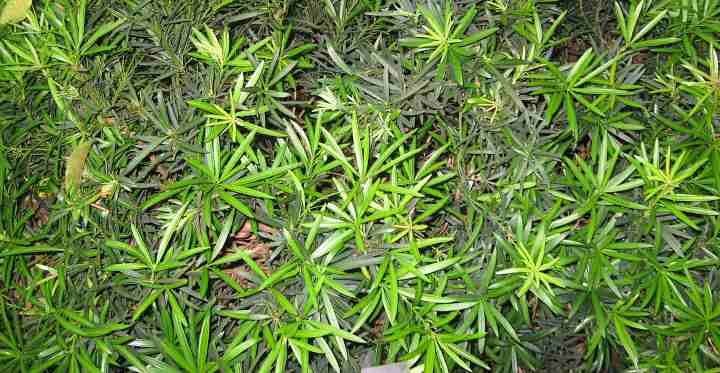
Podocarpus plants are coniferous shrubs with dense evergreen foliage that make excellent lush, bushy low-maintenance hedges. The species Podocarpus macrophyllus also goes by the names fern pine, yew plum pine, and Buddhist pine. Although the Podocarpus plant is commonly called the Japanese yew, it’s not a true member of the Taxaceae family, which the yew belongs to.
Other types of conifers in the family Podocarpaceae are trees and bushy shrubs. For example, the Podocarpus tree (Podocarpus gracilior / Afrocarpus gracilior) is a medium-sized tree that grows in tropical countries. Or, the dwarf Podocarpus (Podocarpus macrophyllus ‘Pringles’) is a low-growing shrub for formal hedges.
In this article, you’ll learn how to grow and care for a Podocarpus hedge. Thanks to its long leathery leaves, dense foliage, and adaptability, this hardy evergreen shrub is an ideal garden landscape shrub.
About Podocarpus Plant
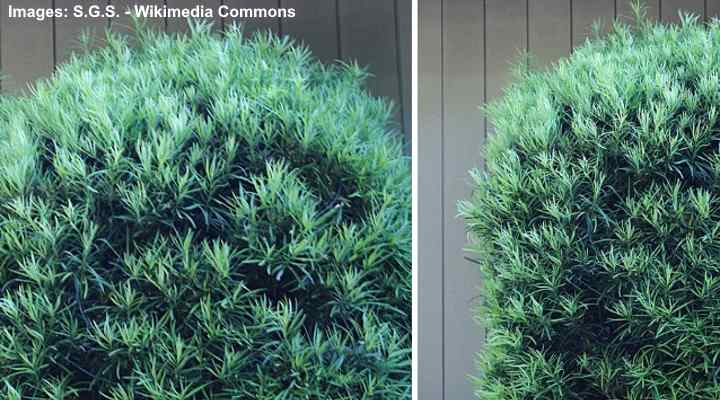
Podocarpus macrophyllus shrubs can be trimmed to control their height and to create a privacy hedge
Podocarpus macrophyllus is a slow-growing, hardy shrub-like tree. The Japanese yew pine has upright, pyramidal growth and grows to between 20 and 40 ft. (6 – 12 m) high. With trimming, you can keep the yew plum pine at a manageable height of 8 to 10 ft. (2.4 – 3 m).
Podocarpus hedges grow best in full sun to partial shade and are ideal shrubs for zones 7 to 10. The yew pines don’t survive cold winters. So, if you live in colder climates, you can grow the shrubs in containers and bring them indoors in winter.
Podocarpus macrophyllus plants thrive in rich, slightly acidic soil that has excellent drainage. Pine yews don’t need much watering and are relatively drought-resistant, making them an easy-care evergreen bushy shrub.
Growing a Podocarpus Hedge
Podocarpus macrophyllus is an ideal shrub for privacy screens, hedges, windbreaks, or natural evergreen barriers. Plant the Podocarpus (Japanese yew pine) shrubs about 2 feet (60 cm) apart and trim them regularly to create a hedgerow. With regular trimming, the Podocarpus shrubs become a beautiful formal soft hedge with thick, dense growth.
What Is Podocarpus Maki (Podocarpus macrophyllus ‘Maki’)
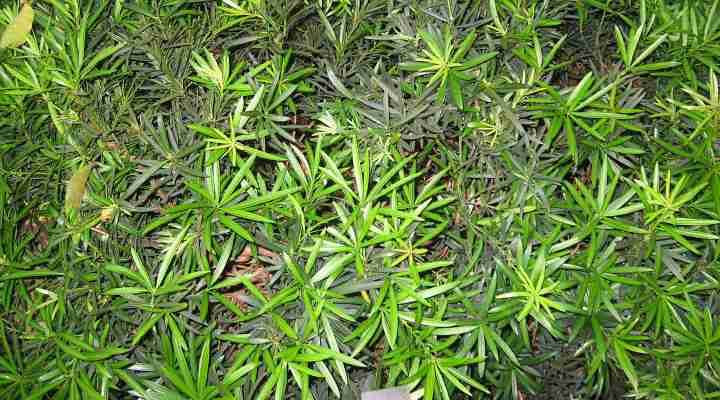
Podocarpus Maki has a dense evergreen foliage and is ideal as a hedge plant
The Podocarpus Maki is an evergreen shrub with upright growth. The small bushy pine yew grows between 6 and 8 ft. (1.8 – 2.4 m) and has a columnar shape. The evergreen shrub looks like a cross between a yew tree and a pine tree.
The Podocarpus Maki is an ideal hedge shrub. The dense foliage adapts well to heavy trimming, and it’s possible to shape its growth. Planting these yew shrubs together can help create an evergreen hedge with attractive fragrant foliage. In colder zones, these Podocarpus shrubs are ideal as container plants.
To grow a Podocarpus Maki shrub, plant it in fertile, slightly acidic soil. Outdoors, the compact hedge shrub prefers full sun or partial shade. However, the evergreen hedge also grows in full shade. The most critical care aspect is to avoid the shrub’s roots sitting in wet soil. So, planting in well-draining ground is vital for growing compact Maki Podocarpus shrubs.
Growing a Podocarpus Tree (Podocarpus gracilior)
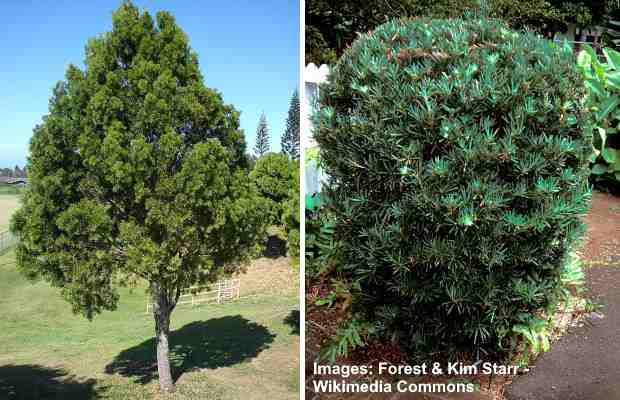
Podocarpus gracilior tree (left) and sheared dwarf tree as a hedge (right)
Podocarpus trees (Podocarpus gracilior) are medium-sized evergreen conifers with a pyramidal shape. Also called weeping Podocarpus trees or African fern trees, the tree has soft, dense evergreen foliage. The slow-growing shade tree grows up to 40 ft. (12 m) high. Podocarpus weeping trees thrive in zones 9 – 11.
Prune the tips of the leaves of Podocarpus trees in the summer if you want to shape the ornamental tree and to encourage fuller growth.
Dwarf Podocarpus (Podocarpus macrophyllus ‘Pringles’)
The dwarf Podocarpus evergreen plant is an ideal compact shrub for ornamental garden landscapes. The small bushy plant has a natural mounded form that’s perfect for low-growing hedges and specimen plants. The short Podocarpus shrub has soft needle-like foliage and grows well in zones 9 and 10.
Dwarf Podocarpus plants grow well in full sun to partial shade. This shrubby plant has a short height and doesn’t require much pruning. However, you can trim the foliage to create a low formal hedge or shape the plant. To grow a low hedge, plant the dwarf Podocarpus shrubs about 2 feet (60 cm) apart.
How to Plant Podocarpus Hedge
Create Podocarpus hedges and lush privacy screens by planting the Podocarpus shrubs close together. The needle-like leaves have a dark green color, and they respond well to trimming. Plant the Japanese yew hedges in the sun or shade and ensure that the ground is fertile and drains well.
Here is what you need to know about planting a Podocarpus hedge:
- Plant a Podocarpus plant in fertile soil that has excellent drainage. If the Podocarpus shrub’s needles lose their color, it’s a sign of overwatering.
- Create a dense evergreen hedgerow by planting Podocarpus shrubs about 2 feet (60 cm) apart. Once established, clip or trim the Japanese yew’s foliage to grow a dense hedge.
- When trimming Podocarpus shrubs for hedges, don’t shear the plant’s sides as they need to grow together. Trim the Podocarpus pine yew so that the top is always a little smaller than the base.
- Grow Podocarpus shrubs in full sun or partial shade. However, don’t worry if the Japanese yew is in the shade as this is also a shade-tolerant plant.
- Make sure the area for growing a Podocarpus hedge is large enough. Pine yew hedges can grow up to 8 ft. (2.4 m) tall with a wide spread.
- Plant Podocarpus macrophyllus as a hedge plant in zones 9 to 11. Remember that pine yews are not cold-hardy and don’t survive frost.
- When planting a Podocarpus hedge, the essential care aspect is appropriate watering. After planting a new Podocarpus hedge shrub, only water it enough to keep the soil moist.
- Pests and diseases rarely affect Podocarpus plant growth.
How to Plant Podocarpus for Landscaping
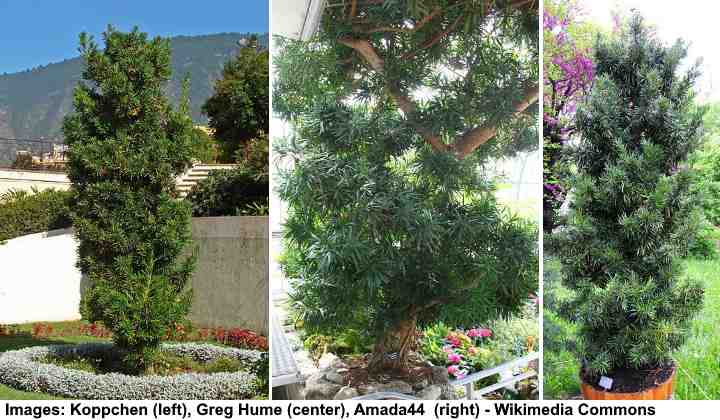
Podocarpus plants can create a vertical focal point in a landscaped garden
Podocarpus trees and shrubs are excellent landscaping plants for your front or backyard. These easy-care ornamental plants make ideal hedgerows, tall hedges, privacy screens, shade trees, or patio container plants.
Small Podocarpus trees and shrubs make beautiful ornamental shaped plants in the yard. Their upright, columnar, or pyramidal growth means that they are ideal specimen trees. You can trim Podocarpus trees to create a ball of foliage on a bare stem, prune the branches for spiral foliage, or create other interesting shapes.
Podocarpus Plant Care
Podocarpus shrubs are low-maintenance plants that are easy to care for in garden landscapes. Water the plant well, allowing the ground to dry out between watering. In sandy soils, add Epsom salt (magnesium sulfate) to prevent a magnesium deficiency. Trim the Podocarpus hedge’s foliage in the summer to keep a neat shape.
Here is some more advice on caring for Japanese yew shrubs.
Light Requirements for Growing Podocarpus Hedge
Podocarpus shrubs thrive in full sun to partial shade. The pine yew hedge prefers getting around six hours of sun a day. However, because these tree-like shrubs are adaptable, they will also grow in the shade. The plant’s growth may slow down if there’s not enough sunshine.
Planting a Podocarpus Japanese yew in full sun results in bushier growth. You’ll also notice that the soft, thin needle leaves have a lighter appearance when the pine yew grows in bright sunshine. Growing in the shade, the plant’s foliage can be sparse, and the leaf color dark green.
The Best Soil for Podocarpus Plant Care
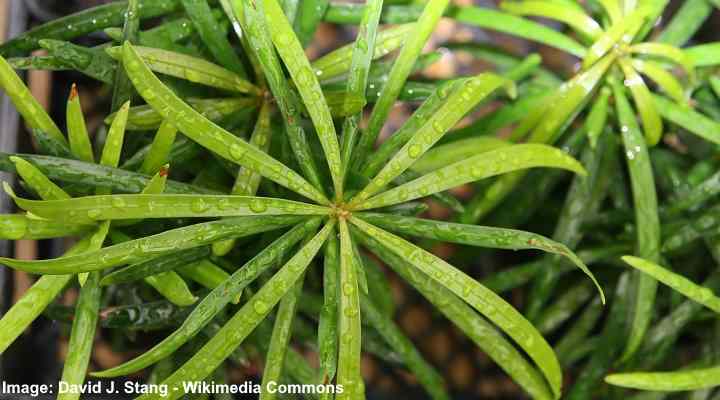
Grow Podocarpus plants in well-draining slightly acidic soil
Podocarpus plants grow best in fertile, slightly acidic soil that is well-draining. But you don’t need to be too fussy where you plant a pine yew bush. The hardy, drought-tolerant shrubs tolerate acidic and neutral soils. You can plant the shrubs in coastal locations as they have moderate salt tolerance.
Podocarpus hedges have a few specific care needs when it comes to the right kind of soil. Here are some of the soil types that can affect Podocarpus hedge growth:
Sandy or loamy soils—Sandy soil can lack magnesium, which is necessary for Podocarpus hedges to thrive. If necessary, add some magnesium sulfate or Epsom salt to help boost the hedge’s growth.
Alkaline soil—Podocarpus shrubs can develop yellow leaves in heavily alkaline soils. Try amending your garden soil with peat moss to improve leaf color on a yellowing Podocarpus.
Wet soil—Yew pines don’t grow well in wet, boggy ground. The ornamental Podocarpus shrubs perform better in moist, but well-draining sandy soil.
Watering Podocarpus Hedges
Podocarpus yew hedges have average water needs. These hardy, drought-tolerant pine yews need moist, but not damp soil to grow. Before the plants are established, they require regular watering. However, established Podocarpus hedges don’t need much water. Just hydrate the Japanese yew often enough to keep the ground moist.
To water Podocarpus shrubs, it’s best to water the soil, not the leaves. Watering from above can result in leaf mold or mildew and spoil the hedge’s appearance.
The best time to water your lush hedge is in the morning. This way, the roots receive proper hydration, and there are fewer issues with fungal diseases.
Temperature and Humidity for Growing Podocarpus Shrubs
Podocarpus fern pines prefer outdoor temperatures between 61°F and 75°F (16°C – 23°C). Japanese yews are not cold hardy, so you shouldn’t grow them as hedges where the temperature drops below 55°F (12°C). Podocarpus hedges are ideal for USDA growing zones 9 to 11.
Species of plants in the genus Podocarpus prefer medium humidity. So, the warm, humid conditions of states such as Florida are perfect for planting Japanese yew hedges.
If you live in colder climates, dwarf Podocarpus, Japanese yews, or bonsai Podocarpus trees are stunning container plants. Keep the plant pots in a warm, sunny spot, but protected from intense sunlight. Water the potting mix just enough to keep the soil slightly moist.
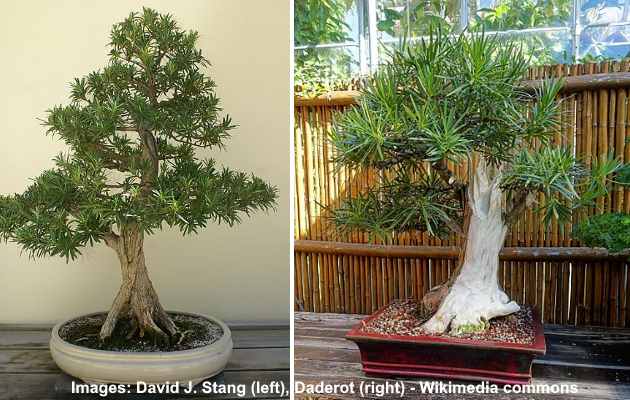
Podocarpus bonsai trees
When to Prune Podocarpus Tree
Trim Podocarpus trees in the summer to encourage secondary growth and then in the fall to encourage new spring growth. Pruning Podocarpus trees and shrubs allows you to create ornaments and shapely landscape trees. You can prune Podocarpus tree foliage into round shapes, cones, or columns.
The only pruning that Podocarpus hedges require is light trimming in the summer. Lightly trim the foliage from the top, front, and back of the hedgerow and allow the side growth to grow together. With the right care and trimming techniques, you can create a soft informal hedge or a compact, stunning formal evergreen hedge.
Although it’s a shrub, you can prune the Podocarpus macrophyllus ‘Maki’ into a compact, upright columnar tree.
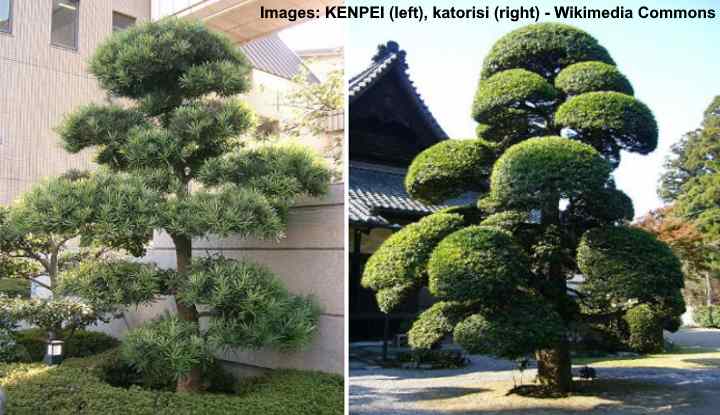
Fully grown Podocarpus macrophyllus trees can be pruned into ornamental shapes such as cloud pruning
Fertilizer Needs for Podocarpus Hedges
Podocarpus hedge shrubs are not heavy feeders and don’t always require additional fertilization. Fertilize the fern pine hedge three times a year—spring, summer, and fall. Use a balanced 6-6-6 fertilizer for Podocarpus shrubs and hedges. This ‘plant food’ provides the right amounts of nitrogen, phosphorus, and potassium.
In addition to the necessary nutrients for healthy hedge growth, Podocarpus hedges benefit from extra iron and sulfur. These additional nutrients help keep the foliage healthy and green.
If you have mainly sandy or loamy soil in your garden, then a Podocarpus privacy screen could suffer from magnesium deficiency. You can increase magnesium levels in the ground by using an Epsom salt solution for plants two or three times a year.
Propagating Podocarpus Shrubs
You can use softwood cuttings from a Podocarpus shrub to propagate new plants. To propagate the plant, cut off new soft growth from a healthy plant. Keep the end of the stem cuttings moist until roots form. Then you can plant the rooted cutting in your garden to extend your hedge.
Here is how to propagate a Podocarpus shrub:
- In summer, take a stem cutting from a healthy Podocarpus plant about 5” (15 cm) from the tip.
- Remove all leaves from the pine yew’s stem apart from a few leaves at the stem’s tip.
- Dip the cut end of the Japanese yew in a rooting hormone.
- Plant the Podocarpus cutting in a container that has well-draining, light potting mix—one part peat and one part perlite is ideal.
- Keep the potting mix moist while the plant takes root.
Because rooting cuttings from evergreen shrubs can be tricky, it is probably easier to buy small Podocarpus shrubs from your local plant nursery to grow in your yard.
Pests Affecting Podocarpus Plant Growth
The primary plant pests to affect Podocarpus hedges are aphids and scale insects. Podocarpus aphids can destroy new plant growth and cause extensive leaf damage. Scale insects suck the pine yew’s sap and can seriously damage the hedge’s growth. You can eradicate these pests by using insecticidal soap or rubbing alcohol.
Aphids on Podocarpus Japanese yews are tiny insects that can be bluish-purple, yellow, red, or orange. Signs of aphids on fern yews are curling new leaves, honeydew, and black sooty mold. You can spray the hedge shrubs with an insecticidal soap or neem oil solution every seven days to get rid of aphids.
Scale insects on pine yew shrubs look like small plate-like growths on the plant’s stems. In time, scale can affect the plant’s growth. However, it needs a large scale insect infection to cause significant hedgerow damage. The easiest way to get rid of scale-infected branches is to prune them and then destroy them.
Diseases Affecting Podocarpus Plant Growth
Podocarpus macrophyllus plants are hardy, sun-loving bushes that are relatively resistant to disease. The most common problems that these shrubby conifers face are connected to waterlogged, soggy soil. Wet soil can create fungal problems in the roots that can affect the plant’s growth.
If you care well for your Podocarpus shrubs, the hedges will grow with minimal care for many years.
Related articles:
